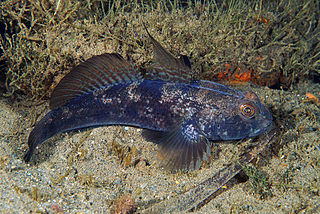
Gobiidae is a family of bony fish in the order Gobiiformes, one of the largest fish families comprising more than 2,000 species in more than 200 genera, sometimes referred to as the "true gobies". Most of them are relatively small, typically less than 10 cm (3.9 in) in length. The Gobiidae includes some of the smallest vertebrates in the world, such as Trimmatom nanus and Pandaka pygmaea,Trimmatom nanus are under 1 cm long when fully grown,then Pandaka pygmaea standard length are 9mm ,maximum known standard length are 11 mm. Some large gobies can reach over 30 cm (0.98 ft) in length, but that is exceptional. Generally, they are benthic, or bottom-dwellers. Although few are important as food for humans, they are of great significance as prey species for commercially important fish such as cod, haddock, sea bass, and flatfish. Several gobiids are also of interest as aquarium fish, such as the dartfish of the genus Ptereleotris. Phylogenetic relationships of gobiids have been studied using molecular data.

The tiger pistol shrimp belongs to the family of snapping shrimp.
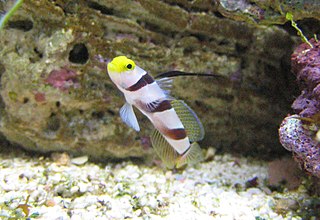
Stonogobiops nematodes, the Filament-finned prawn-goby, the high-fin goby, the red-banded goby, the high-fin red-banded goby, the striped goby, the barber-pole goby, or the black-ray Goby, is a species of marine goby native to the Indian Ocean and western Pacific Ocean from the Seychelles to the Philippines and Bali.

Amblyeleotris is a genus of fish in the family Gobiidae found throughout the Indo-Pacific region. This is the largest genus of the shrimp gobies or prawn gobies, so-called because of their symbiotic relationship with certain alpheid shrimps. The shrimp excavates and maintains a burrow used by both animals while the goby, which has far superior eyesight, acts as a lookout for predators. The shrimp maintains almost constant contact with the fish with an antenna.These species vary considerably in size from less than 30 mm to almost 200 mm standard length.
Amblyeleotris rubrimarginata is a species of goby found on reefs or in sea grass beds in the western Pacific from New Caledonia to the Great Barrier Reef and around New Guinea, Indonesia, Malaysia and the Philippines. It can be found at depths of from 3 to 26 metres. As with other Amblyeleotris species, it has a symbiotic relationship with alpheid shrimps, one or a pair of gobies sharing a burrow with a pair of shrimps.
Amblyeleotris harrisorum is a species of goby currently only recorded from reefs around the island of Kiritimati in the Line Islands, Republic of Kiribati, in the central Pacific at a depth of around 32 metres (105 ft). As with other Amblyeleotris species, it has a symbiotic relationship with alpheid shrimps.

Amblyeleotris steinitzi, Steinitz' prawn goby or simply Steinitz' goby, is a species of small fish in the family Gobiidae. It lives in association with an alpheid shrimp and is found from the Red Sea through the Indian Ocean to the western Pacific Ocean.
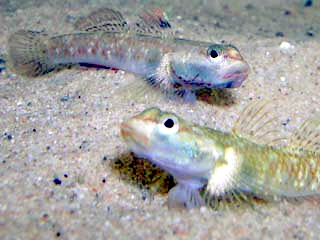
The Gobiiformes are an order of fish that includes the gobies. The order, which was previously considered a suborder of Perciformes, is made up of 2,211 species that are divided into seven different families. Phylogenetic relationships of the Gobiiformes have been elucidated using molecular data. Gobiiforms are generally small fish and are mostly marine (saltwater) fishes, but roughly 10% of the population inhabit fresh waters. This order is made up of mainly benthic or sand-burrowing fish. Benthic fish live on the bottom of a body of water. Like in most benthic organisms, gobiiforms do not have a gas bladder or swim bladder which keeps them from suspending in the water column, so they must stay on the bottom.

Ptereleotris hanae, the blue hana goby, is a species of dartfish native to the western Pacific Ocean. It is a reef inhabitant, being found at depths of from 3 to 50 metres, though usually no shallower than 6 metres (20 ft). It inhabits burrows made by alpheid shrimp, but unlike the Amblyeleotris gobies who normally associate with these shrimp, this species has no interactions with their shrimp hosts. This species can reach a length of 12 centimetres (4.7 in) TL. It can also be found in the aquarium trade.

Amblyeleotris guttata, theSpotted prawn-goby is a species of goby native to reefs of the Western Pacific Ocean, that includes the Philippines to Tonga, north to the Ryukyu Islands, south to Australia.
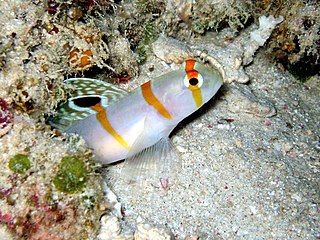
Amblyeleotris randalli, Randall's prawn goby, is a marine benthic species of goby native to tropical reefs of the central Indo-Pacific. This species can also be found in the aquarium trade.

Amblyeleotris wheeleri, the Gorgeous prawn-goby, is a species of goby native to tropical reefs of the Indian Ocean to the western Pacific Ocean. It can be found at depths of from 5 to 40 metres though is usually does not occur deeper than 15 metres (49 ft). It is a commensal with alpheid shrimps, most often being found in association with Alpheus ochrostriatus. This species can reach a length of 10 centimetres (3.9 in) SL. It can also be found in the aquarium trade. The specific name honours the English ichthyologist Alwynne Cooper Wheeler (1929-2005), who was curator of Fishes at the British Museum, "for his help over the years, particularly with the authors’ study of prawn-associated gobies of the Seychelles".

Amblyeleotris diagonalis, the Diagonal shrimpgoby, is a species of goby native to the Indian Ocean and the western Pacific Ocean where it can be found on reefs at depths of from 6 to 40 metres. It is commensal with alpheid shrimps. This species can reach a length of 11 centimetres (4.3 in) SL.
Amblyeleotris aurora, the pinkbar goby, is a species of goby native to reefs of the western Indian Ocean at depths of from 5 to 40 metres though usually not deeper than 10 metres (33 ft). It is commensal with the shrimp Alpheus randalli. This species can reach a length of 11 centimetres (4.3 in) TL. It can also be found in the aquarium trade.

Alpheus randalli is a species of snapping shrimp in the genus Alpheus. It lives in the Marquesas Islands and parts of the Indian Ocean, including the Seychelles, in association with a goby of the genus Amblyeleotris. The shrimp is transparent or white with prominent red markings.
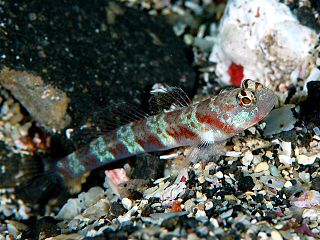
Amblyeleotris periophthalma, the broad-banded shrimp goby or the periophthalma shrimp goby, is a marine benthic species of goby native to reef environments of the Indo-West Pacific, Red Sea included.

The arrow goby is a species of goby native to marine and brackish waters of the Pacific coast of North America from British Columbia to Baja California. This species grows to a length of 6.4 centimetres (2.5 in) SL though most do not exceed 4.2 centimetres (1.7 in) TL. This fish can also be found displayed in public aquaria. This species is the only known member of its genus.
Lotilia is a small genus of gobies native to the Indo-Pacific region. The members of this genus are commensal with shrimps of the genus Alpheus.
The orangespotted goby is a species of goby native to the tropical Atlantic coast from Bermuda and southern Florida through the Caribbean Sea and Gulf of Mexico south to the Caribbean coasts of Venezuela and Colombia, where it prefers silty bottoms around reefs. It is a commensal with an alpheid shrimp. This species grows to a length of 10 centimetres (3.9 in) TL. This species is the only known member of its genus.
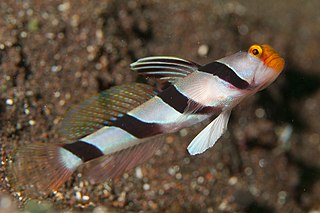
Stonogobiops is a genus of gobies native to the Indian and Pacific oceans. This is one of the "shrimp goby" genera, the members of these genera being commensal with various species of shrimps.
















